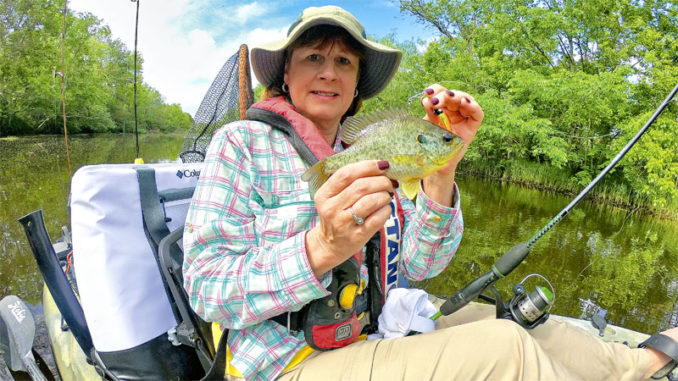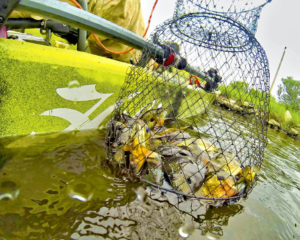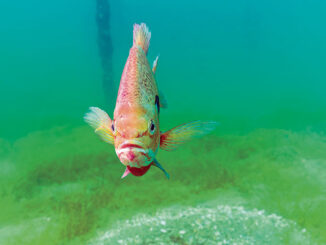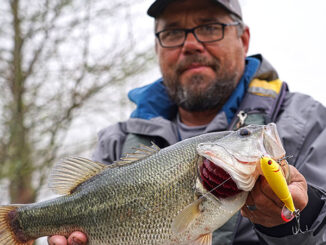
For many anglers, especially if they started fishing as a child, their first fish was likely caught on a cane pole. Simple and inexpensive, this highly effective way of fishing has generally lost out to technology and more-expensive fishing tackle. However, for kayak anglers looking to have a blast and get back to their fishing roots, a modern cane pole provides all-day action for a pile of tasty, hard-fighting panfish.
Old, natural bamboo poles still work well but are a bit difficult to manage in a kayak. Modern, telescopic fiberglass poles provide the same thrilling action, but are easy to carry in a ’yak and cost less than $20. Rigged with a simple, adjustable cork, a split-shot and a small, long-shank hook, you have all you need for a day of bream-busting that conjures up memories of days gone by. Collectively called panfish, bream, perch, bluegills, sunfish or a host of other colloquial names, Louisiana has a variety of species, and these hand-sized fish are voracious eaters and fight like mini bulldogs.
Kayaks are well suited for chasing panfish. Found in fresh and brackish waters across the state, kayaks can get you to virtually un-fished areas that teem with these tasty morsels. Be it a lake, bayou, canal or ditch, if it has water and little salinity, you can bet you’ll find some action. Another factor many anglers don’t realize is that as many areas in south Louisiana turn fresher due to diversions and hurricane protection projects, panfish have spread into many areas that were more recently home to only saltwater species. If you have a spot where you catch reds and bass, rest assured that panfish are there also.
Bait
For cane poles, a pile of earthworms — buy or dig your own — is all you need for bait. With the worm threaded on the hook, bites generally come in mere seconds if you’re in the right spot. Look for logs, pilings, trees or any nearshore structure where these fish congregate. Even overhanging brush or tree limbs provide shaded areas that also produce fish. You can generally pull several fish off of one spot before moving to the next. Start off setting the hook about 18 inches deep. This generally gets the bait down to where the larger fish are, and you can easily raise it up several inches if necessary. Once the larger fish play out, simply move to another spot and repeat.
Rig the line so that it barely reaches the bottom of the pole. This makes it easy to simply lift the rod and precisely place your bait, as well as swing the fish right to you for removal. Other baits such as live crickets, grass shrimp and small bits of shrimp also work well, but there is just something about that earthworm wiggle and smell that make them the No. 1 choice.
If a cane or fiberglass pole is not your style, a small, ultralight spinning outfit or a 3-weight fly rod work well also. Tiny artificial baits like a Beetle Spin or mini-crankbait are great for catching larger panfish, as well as the occasional bass, crappie or catfish. If you choose the fly rod, small floating bugs and poppers are easily gobbled up by aggressive fish.
The benefits of a kayak

The ease of catching panfish is enhanced by the kayak. You can easily and quietly move into areas where no one has ever fished for them. Look for popular roadside fishing spots as keys to areas that hold good concentrations of fish. Launch and head away from the bank, and you’ll likely find fish in areas they cannot reach. In addition to your favorite baits and lures, a small pair of forceps or needle nose pliers comes in handy for removing those tiny hooks.
Many areas also have now seen an insurgence of invasive Rio Grande cichlids. They are fun to catch and also hard fighters. They hit all the same baits and lures as the native species, and odds are that you may catch a few during your trip.
However, due to concerns that their aggressive nature could displace native species, special rules prohibit catch and release of Rios or possessing them live. Therefore, if you use a stringer or a basket to keep your catch, you should dispatch Rios first by sticking them in the head with an ice pick or cutting through the gills. However, it’s easier to carry a small ice chest for keeping the Rios in accordance with the law. They are tasty and really shouldn’t be discarded. And they are quite pretty fish, dark colored, sometimes almost black, with iridescent spots. They can grow much larger than native panfish, and the males often have a large hump on their forehead.
Bring the kids
Chasing panfish is best in the early morning or late afternoon, which is great for fishing on hot, summer days. It is also a great way to introduce others to kayak fishing, especially kids. No long paddles are necessary, and they are mostly found in protected waters. The action is usually fast and nonstop and easily keeps up the interest. Fighting these fish on a cane pole or other light gear is a challenge and quite exciting. If you haven’t tried it in a while, you owe it to yourself relive the memories of days gone by. Doing it up close and personal in a kayak simply adds to the fun.

